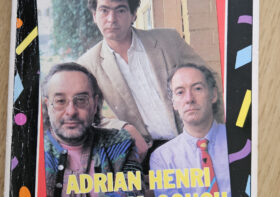Audio poem (an experiment)
I was inspired by Mark Hewitt’s performance of ‘expiry tbc‘ the other evening here in Lewes. It was actually a 3-person production featuring Peter Copley on live (and looped) cello, and wonderful lighting effects by Kristina Hjelm. I’d had the privilege of being in Mark’s workshopping group led by Mimi Khalvati earlier in the year, and he had brought along various versions of the text. But although some of the words were familiar, it was amazing how exciting and moving the whole package became with the addition of sound, light and staging. I’ve often fallen into the trap of thinking that performance poetry is mostly about shouting, rhyming and making the audience laugh. But this was something else entirely.
So I went back to my ‘3 voice canon’ poem – the one I sent to Magma for their theme ‘The music of words’ (still open for admissions, by the way) but was rejected, because they said they couldn’t see the connection between the stanzas, and I recorded it the way I envisage it being read. I used a bit of software called Audacity, in which it’s easy to record one track and layer copies of it over the top in a stagger. I was having so much fun I gave it four tracks in the end. So maybe I should re-title it ‘4-voice canon’?
I did it on one take, so I’m sure I could improve on it, although I don’t want to start putting on silly voices or making it over dramatic. Let me know what you think – thanks.



I really like the layering of voices, Robin, and the idea of a spoken canon.
Today’s email notifications reminded me that you might consider submitting it to Radio Wildfire. Here’s the link:
http://www.radiowildfire.com/listen/
Thanks Jayne, I will check that out…
Is it a train journey, Robin? That’s what it reminds me of.
Yes kind of – both a morning commute and a dawn chorus in one.
Lovely!
Thanks 🙂
I thought this was great, Robin. My own idea re: music, was to read a poem along the lines of Spalding Gray’s story-telling in the Jonathan Demme film, “Swimming to Cambodia, where you read against different backgrounds of mood music and lighting. In the right context, the combination could be very affecting. You may not know this, but Allen Ginsberg used to read his poems while he played a harmonium. I saw him do it live at St. Mark’s Church and it was a pretty interesting experience. Now you can see Gray and Ginsberg on youtube.
Thanks Steven – that’s fascinating, I don’t know ‘Swimming to Cambodia’ but will check it out. I’ve also just been trawling YouTube and listening to Ginsberg read ‘America’, wonderful stuff. I’m envious of you having gotten to see him perform.
Wow, amazing how you have got the harmonies to work x
Thanks Kathy – although I think it was more luck than design!
Only just caught up with this, Robin – enjoyed the idea, and I liked the way that when listening you could opt to follow one of the voices rather than the other, rather like in a string quartet. It did strike me though that it would be more interesting if there were more variations in tone between the different voices – a little pain au chocolat please (have I got that right) came out with more rhythm than expression. I think that if you’re going this route you have to put more into the performance side. Well worth developing the idea. You could well reach a situation like those operatic quartets/quintets/sextets where everyone is saying different things and voicing different feelings at the same time. The third act of Bohème occurs to mind but that may be a false trail.
Hi Antony – thanks so much for your feedback -good idea about more variation, I did think it was probably a bit monotonous, in live performance it would be different voices each putting their own stamp on it – much more interesting in one way, although I still like the idea of multitracking the same voice, perhaps paying more attention to where each voice comes in, to allow phrases to pop through. I know what you mean about the operatic thing of different lines being sung simultaneously – I’ve seen that in church music too, where the Credo is made shorter by giving different sections of it to the different voice parts! A bit cheeky really 🙂
Actually I thought the multitracking of the same voice worked well and opened up a whole lot of other possibilities – such as internal dialogue versus external interaction; also I’ve not come across it as a technique before (except for those digitally manipulated recordings where a soprano sings a duet with herself). So there’s quite a lot to pursue down this road, if that isn’t a mixed metaphor.
This was both mesmerising and meditative, and i liked that some phrases popped oout more thn others (especially when the phrase is about pain au chocolate, nome!) 🙂 Would like to hear more of these!
nom, not nome! what the heck is a nome?!
Isn’t that a little fella with a pointy hat in the garden … tee hee! Thanks for commenting Jay 🙂